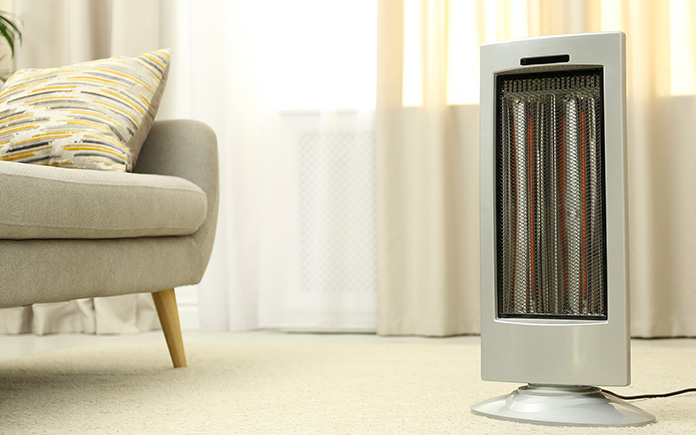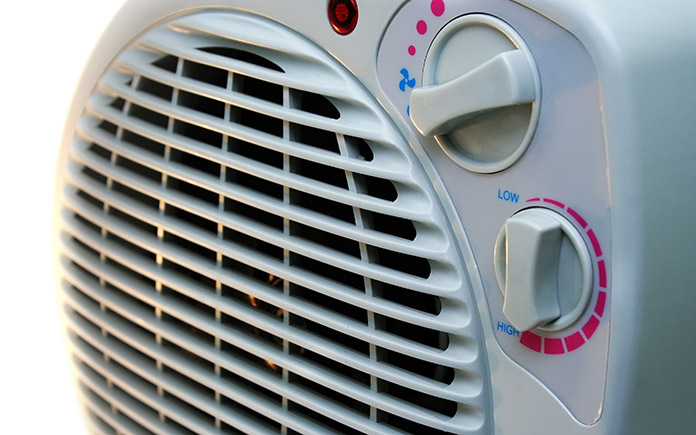
When shopping for an electric, gas or kerosene space heater, remember, not all of these appliances are created equal. Here are tips to choose the safest space heater.
In addition, at the bottom, check out our guidelines on how to properly operate a space heater to prevent fire hazards.
Choosing the Safest Space Heater
When you’re at the home center, keep these pointers in mind before selecting a space heater.
1. Make sure it’s been tested. Choose a space heater that has been tested and certified by an independent laboratory such as UL, ETL or CSA. You probably won’t find many appliances not vetted by one of these labs, but always check the box to be sure.



2. Look for its guard. Make sure the space heater you buy has a guard in front of the heating element or flame. This used to be a real problem with older space heaters, but for the most part, you shouldn’t see newer appliances without guards.
3. Pick the right fit. Choose a space heater sized for the space you plan to heat. If you choose a space heater that’s rated to warm rooms much smaller than yours, the result is inefficiency, straining the appliance and possibly overheating it, which could result in fires.
4. Get one with a thermostat. When you set the desired temperature, the space heater will cycle on and off to maintain that temperature. This is one of the safest space heater features because it prevents overheating the room.
5. Look for an anti-tip feature. This means if the appliance tips over, it will immediately turn off, which prevents a major fire hazard.
Space Heater Safety Guidelines
Choosing the safest space heater, on paper, is one thing, but operating the appliance is another matter entirely. Having the right appliance only accounts for so much; you need to do your part as well to prevent hazards.
Keep these tips in mind when operating your space heater:
1. Only operate a space heater on a hard, level surface. This helps prevent the appliance from tipping over.
2. Make sure the space heater stays at least 3 feet from fabric, such as bedding, drapes, furniture or children’s toys, as well as holiday decorations and artificial trees.



3. Never use a space heater to dry clothing or blankets. The appliance isn’t intended for this purpose, it will be ineffective, and close contact with clothes and blankets is a major fire hazard.
4. Don’t leave a space heater running unattended or when you’re asleep. If you’re asleep, you can’t monitor overheating, and you won’t know if the appliance fails and starts a fire.
5. Supervise children and pets at all times when a space heater is in use. Curious little hands and paws, plus a space heater, are an accident waiting to happen.
6. Avoid using an extension cord with electric space heaters. Space heaters should be plugged directly into the wall. This prevents overheating the extension cord, which could cause a fire.
7. Never run a space heater power cord under a rug or carpet. People can walk on rugs and carpeting, and this can lead to frayed cords — never a good thing when you’re dealing with anything electrical, especially a space heater.
8. Have gas and kerosene space heaters inspected annually to ensure that they aren’t releasing carbon monoxide, or other harmful pollutants, into your home. Also, install a carbon monoxide detector, and replace the batteries promptly, as needed.
Operating a space heater is an efficient way to supplement your furnace or heat pump when temperatures dip, but you need to choose the safest space heater, and then use it responsibly to enjoy its full benefits.
Watch this video to find out more.
Further Information
   | It’s Heat Your Home Week, sponsored by American Standard Heating and Air Conditioning! Want to make sure your home is nice and toasty from the first cold snap?Click for all the money-saving advice you need to stay warm and comfortable. |
VIDEO TRANSCRIPT Danny Lipford: When the weather gets really cold outside, lots of people use space heaters to supplement their home’s heating system; or to warm areas, like this garage, that aren’t connected to their furnace.
Now that’s not a bad idea, but there are some very important safety considerations that go along with using this kind of heater.
First, be sure that it’s tested and certified by a nationally recognized testing laboratory and that the heating element or flame is covered by a guard.
Then you want to choose a heater that’s the right size for the area you want to heat. If it’s too big or too small, it won’t operate efficiently or safely.
It’s also a good idea to pick a model that’s thermostatically controlled so that it doesn’t overheat the space.
Now, once you have chosen a heater, locate it on a hard, level surface at least 3 feet away from fabrics, like bedding, drapes or furniture.
For electric units, avoid using extension cords if at all possible, and never run the power cord under a rug or carpet. Both of these situations can lead to overheating and the possibility of fire.
Gas and kerosene models should be inspected annually to ensure that they aren’t releasing harmful pollutants into the home.
And, finally, never leave the space heater running when you go to sleep or leave the area.
Be safe and stay warm this winter!




